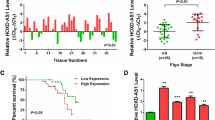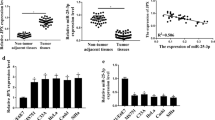Abstract
Purpose
Long noncoding RNAs (lncRNAs) have been gradually regarded as influential indicators of various cancers. The present study aimed to identify the effects of lncRNA HOTAIR on cervical cancer progression.
Methods
RNA and protein expressions were quantified by RT-qPCR and western blot assays. Fluorescence in situ hybridization (FISH) assay was carried out to examine the intracellular location of HOTAIR. Cancer cell viability and mobility were detected by CCK-8, colony formation, transwell and wound healing assays. Binding relationships between miR-331-3p and HOTAIR/RCC2 were validated by luciferase reporter assay.
Results
RT-qPCR assays showed that HOTAIR levels were notably upregulated in cervical cancer tissues and cell lines. Furthermore, a fluorescence in situ hybridization (FISH) assay suggested that HOTAIR was mostly located in the cytoplasm of cancer cells, indicating a sponging function. CCK-8, colony formation, Transwell and wound-healing assays indicated that knockdown of HOTAIR in HeLa and SiHa cells significantly reduced cell growth, migration and invasion. Subsequently, miR-331-3p was proven to be the target molecule of HOTAIR. In addition, results from Pearson's correlation analysis indicated negative correlation between HOTAIR and miR-331-3p in cervical cancer tissues. HOTAIR negatively modulated miR-331-3p expression. Ultimately, the target gene of miR-331-3p was verified to be RCC2, and miR-331-3p negatively modulated RCC2 expression. In addition, analysis on clinical cervical cancer tissues confirmed the negative correlation between miR-331-3p and RCC2. HOTAIR and RCC2 showed oncogenic functions in HeLa and SiHa cells, while miR-331-3p exerted the reverse effect.
Conclusions
HOTAIR plays a carcinogenic role in cervical cancer by targeting the miR-331-3p/RCC2 axis. Moreover, clinical cervical cancer tissues confirmed the negative correlation between miR-331-3p with lncRNA HOTAIR and RCC2. These data suggested an underlying therapeutic target for cervical cancer.





Similar content being viewed by others
Data availability
The datasets used and/or analyzed during the current study are available from the corresponding author on reasonable request.
References
Bray F, Ferlay J, Soerjomataram I, Siegel RL, Torre LA, Jemal A. Global cancer statistics 2018: GLOBOCAN estimates of incidence and mortality worldwide for 36 cancers in 185 countries. CA Cancer J Clin. 2018;68:394–424.
Ouh YT, Lee JK. Proposal for cervical cancer screening in the era of HPV vaccination. Obstet Gynecol Sci. 2018;61:298–308.
Vaccarella S, Franceschi S, Zaridze D, Poljak M, Veerus P, Plummer M, et al. Preventable fractions of cervical cancer via effective screening in six Baltic, central, and eastern European countries 2017–40: a population-based study. Lancet Oncol. 2016;17:1445–52.
Fattahi S, Kosari-Monfared M, Golpour M, Emami Z, Ghasemiyan M, Nouri M, et al. LncRNAs as potential diagnostic and prognostic biomarkers in gastric cancer: A novel approach to personalized medicine. J Cell Physiol. 2020;235:3189–206.
Javed Z, Ahmed Shah F, Rajabi S, Raza Q, Iqbal Z, Ullah M, et al. LncRNAs as Potential Therapeutic Targets in Thyroid Cancer. Asian Pac J Cancer Prev. 2020;21:281–7.
Dastmalchi N, Safaralizadeh R, Nargesi MM. LncRNAs: Potential Novel Prognostic and Diagnostic Biomarkers in Colorectal Cancer. Curr Med Chem. 2020;27:5067–77.
Aalijahan H, Ghorbian S. Long noncoding RNAs and cervical cancer. Exp Mol Pathol. 2019;106:7–16.
Hua JT, Chen S, He HH. Landscape of Noncoding RNA in Prostate Cancer. Trends Genet. 2019;35:840–51.
Paraskevopoulou MD, Hatzigeorgiou AG. Analysing MiRNA-LncRNA Interactions. Methods Mol Biol. 2016;1402:271–86.
Wang Z, Liu Y. Predicting Functional MicroRNA-mRNA Interactions. Methods Mol Biol. 2017;1580:117–26.
Chen LL. Linking Long Noncoding RNA Localization and Function. Trends Biochem Sci. 2016;41:761–72.
Xu J, Zhang J. LncRNA TP73-AS1 is a novel regulator in cervical cancer via miR-329-3p/ARF1 axis. J Cell Biochem. 2020;121:344–52.
Liang H, Zhang C, Guan H, Liu J, Cui Y. LncRNA DANCR promotes cervical cancer progression by upregulating ROCK1 by sponging miR-335-5p. J Cell Physiol. 2019;234:7266–78.
Hu T, Zhang Q, Gao L. LncRNA CAR10 Upregulates PDPK1 to Promote Cervical Cancer Development by Sponging miR-125b-5p. Biomed Res Int. 2020;2020:4351671.
Liu M, Jia J, Wang X, Liu Y, Wang C, Fan R. Long noncoding RNA HOTAIR promotes cervical cancer progression through regulating BCL2 by targeting miR-143-3p. Cancer Biol Ther. 2018;19:391–9.
Liu XH, Sun M, Nie FQ, Ge YB, Zhang EB, Yin DD, et al. Lnc RNA HOTAIR functions as a competing endogenous RNA to regulate HER2 expression by sponging miR-331-3p in gastric cancer. Mol Cancer. 2014;13:92.
Wu J, Jin L, Zhang Y, Duan A, Liu J, Jiang Z, et al. LncRNA HOTAIR promotes endometrial fibrosis by activating TGF-β1/Smad pathway. Acta Biochim Biophys Sin (Shanghai). 2020;52:1337–47.
Sun Y, Hu ZQ. LncRNA HOTAIR aggravates myocardial ischaemia-reperfusion injury by sponging microRNA-126 to upregulate SRSF1. Eur Rev Med Pharmacol Sci. 2020;24:9046–54.
Mao T, He C, Wu H, Yang B, Li X. Silencing lncRNA HOTAIR declines synovial inflammation and synoviocyte proliferation and promotes synoviocyte apoptosis in osteoarthritis rats by inhibiting Wnt/β-catenin signaling pathway. Cell Cycle. 2019;18:3189–205.
Zhou W, He X, Chen Z, Fan D, Wang Y, Feng H, et al. LncRNA HOTAIR-mediated Wnt/β-catenin network modelling to predict and validate therapeutic targets for cartilage damage. BMC Bioinformatics. 2019;20:412.
Lin Q, Hou S, Dai Y, Jiang N, Lin Y. LncRNA HOTAIR targets miR-126-5p to promote the progression of Parkinson’s disease through RAB3IP. Biol Chem. 2019;400:1217–28.
Gao L, Wang X, Guo S, Xiao L, Liang C, Wang Z, et al. LncRNA HOTAIR functions as a competing endogenous RNA to upregulate SIRT1 by sponging miR-34a in diabetic cardiomyopathy. J Cell Physiol. 2019;234:4944–58.
Zhao W, Geng D, Li S, Chen Z, Sun M. LncRNA HOTAIR influences cell growth, migration, invasion, and apoptosis via the miR-20a-5p/HMGA2 axis in breast cancer. Cancer Med. 2018;7:842–55.
Peng CL, Zhao XJ, Wei CC, Wu JW. LncRNA HOTAIR promotes colon cancer development by downregulating miRNA-34a. Eur Rev Med Pharmacol Sci. 2019;23:5752–61.
Yan ZC, He L, Qiu JH, Deng WT, Lu JR, Yuan Z, et al. LncRNA HOTAIR participates in the development and progression of adrenocortical carcinoma by regulating cell cycle. Eur Rev Med Pharmacol Sci. 2018;22:6640–9.
Zhang H, Wang R, Wang M. miR-331-3p suppresses cell invasion and migration in colorectal carcinoma by directly targeting NRP2. Oncol Lett. 2019;18:6501–8.
Tian QQ, Xia J, Zhang X, Gao BQ, Wang W. miR-331-3p Inhibits Tumor Cell Proliferation, Metastasis, Invasion by Targeting MLLT10 in Non-Small Cell Lung Cancer. Cancer Manag Res. 2020;12:5749–58.
Zhao M, Zhang M, Tao Z, Cao J, Wang L, Hu X. miR-331-3p Suppresses Cell Proliferation in TNBC Cells by Downregulating NRP2. Technol Cancer Res Treat. 2020;19:1533033820905824.
Yu H, Zhang S, Ibrahim AN, Wang J, Deng Z, Wang M. RCC2 promotes proliferation and radio-resistance in glioblastoma by activating transcription of DNMT1. Biochem Biophys Res Commun. 2019;516:999–1006.
Calderon-Aparicio A, Yamamoto H, De Vitto H, Zhang T, Wang Q, Bode AM, et al. RCC2 Promotes Esophageal Cancer Growth by Regulating Activity and Expression of the Sox2 Transcription Factor. Mol Cancer Res. 2020;18:1660–74.
Chen Z, Wu W, Huang Y, Xie L, Li Y, Chen H, et al. RCC2 promotes breast cancer progression through regulation of Wnt signaling and inducing EMT. J Cancer. 2019;10:6837–47.
Chen Q, Jiang P, Jia B, Liu Y, Zhang Z. RCC2 contributes to tumor invasion and chemoresistance to cisplatin in hepatocellular carcinoma. Hum Cell. 2020;33:709–20.
Zhang M, Song Y, Zhai F. ARFHPV E7 oncogene, lncRNA HOTAIR, miR-331-3p and its target, NRP2, form a negative feedback loop to regulate the apoptosis in the tumorigenesis in HPV positive cervical cancer. J Cell Biochem. 2018;119:4397–407.
Acknowledgements
We gratefully acknowledge the financial support from the State Key Laboratory of Pathogenesis, Prevention and Treatment of High Incidence Diseases in Central Asia Fund. At the same time, we would like to thank all the researchers and study participants for their contributions.
Funding
This study was supported by grants from the State Key Laboratory of Pathogenesis, Prevention and Treatment of High Incidence Diseases in Central Asia Fund (Grant number: SKL-HIDCA-2019–31).
Author information
Authors and Affiliations
Contributions
GB and GA are responsible for the conception or design of the work. GB, AA, XL and GA contributed to the acquisition, analysis, and interpretation of the data for the work. AA and XL provided the tissue samples. AA helped in the follow-up of the patients. XL helped in reviewing the histopathology slides. GB is the guarantor of the article. All authors approved the final manuscript version to be published.
Corresponding author
Ethics declarations
Conflict of interest
The authors declare that they have no conflict of interest.
Ethical approval
The study was approved by Ethical Committee of Xinjiang Medical University Third Clinical Medical College (Affiliated Tumor Hospital) and conducted in accordance with the ethical standards.
Informed consent
Not applicable.
Additional information
Publisher's Note
Springer Nature remains neutral with regard to jurisdictional claims in published maps and institutional affiliations.
Rights and permissions
Springer Nature or its licensor (e.g. a society or other partner) holds exclusive rights to this article under a publishing agreement with the author(s) or other rightsholder(s); author self-archiving of the accepted manuscript version of this article is solely governed by the terms of such publishing agreement and applicable law.
About this article
Cite this article
Buranjiang, G., Abuduwanke, A., Li, X. et al. LncRNA HOTAIR enhances RCC2 to accelerate cervical cancer progression by sponging miR-331-3p. Clin Transl Oncol 25, 1650–1660 (2023). https://doi.org/10.1007/s12094-022-03059-4
Received:
Accepted:
Published:
Issue Date:
DOI: https://doi.org/10.1007/s12094-022-03059-4




